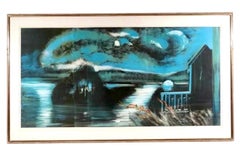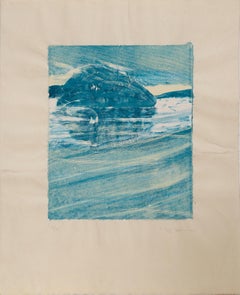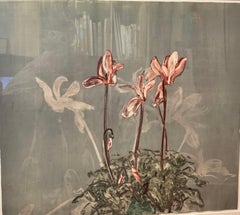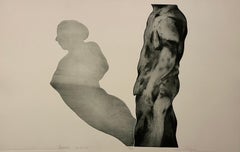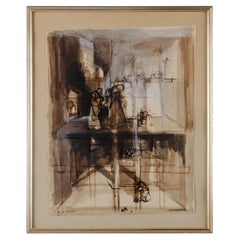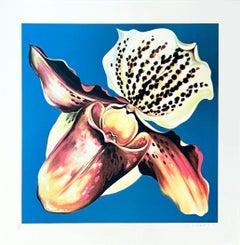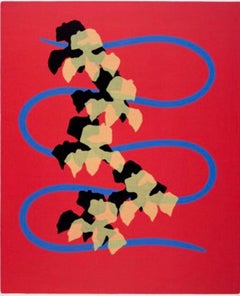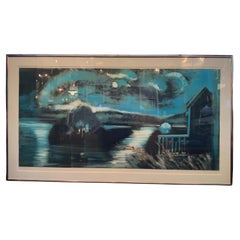Michael Mazur Art
American, 1935-2009
Michael Mazur (b. 1935, New York, NY – d. 2009, Cambridge, MA) is internationally recognized for his paintings, drawings, and prints and for his fluidity between media. Mazur is unusual among artists in that he worked successfully in both abstract and representational imagery, influenced by elements of Impressionism, Abstract Expressionism, and early Chinese paintings. He was instrumental in the revival of the monotype in 20th-century art and renowned for his pastels, as well.Mazur’s work is in numerous prominent museum collections, including the British Museum, UK; Cincinnati Art Museum, OH; Cleveland Museum of Art, OH; de Cordova Museum, Lincoln, MA; Los Angeles County Museum of Art, CA; Museum of Fine Arts, Boston, MA; Art Institute of Chicago, IL; McNay Art Museum, San Antonio, TX; Metropolitan Museum of Art, NY; Museum of Modern Art, NY; Philadelphia Museum of Art, PA; Smith College, MA; Whitney Museum of American Art, NY; Yale University Art Gallery, CT; and Zimmerli Art Museum at Rutgers University, NJ.
Mazur has been included in solo and group exhibitions at RYAN LEE (2018), Nagoya/Boston Museum of Fine Arts (2018), de Saisset Museum, Santa Clara University (2017), Mead Art Museum, Amherst College (2017), deCordova Sculpture Park and Museum (2016), The Print Center, Philadelphia (2015), International Print Center of New York (2015) and the Boston Museum of Fine Art (2006). In 2000, the Museum of Fine Arts, Boston held a retrospective, which later traveled to Stanford University Art Museum, the Jane Vorhees Zimmerli Art Museum at Rutgers University, and the Minneapolis Institute of Art. An accompanying catalogue was published by the Museum of Fine Arts, Boston. Mary Ryan Gallery has held 14 solo exhibitions featuring Mazur’s work between 1990 and 2010.to
5
4
3
2
1
1
1
1
Large American Modernist Monotype Michael Mazur The Lake Expressionist Landscape
By Michael Mazur
Located in Surfside, FL
Michael Mazur (American, 1935-)
Hand signed and titled
The Lake II, 1985
Color monotype
Hand signed, titled, and dated in pencil lower margin
Dimensions overall: 47 x 82 in. (frame) ...
Category
1980s American Modern Michael Mazur Art
Materials
Monoprint, Monotype
Wakeby Island, Conceptual Art Woodcut Print by Michael Mazur
By Michael Mazur
Located in Long Island City, NY
Artist: Michael Mazur, American (1935 - 2009)
Title: Wakeby Island
Year: circa 1990
Medium: Color woodcut with chine collé, signed and numbered in pencil
Edition: 15
Image Size: 15 x...
Category
Late 20th Century Contemporary Michael Mazur Art
Materials
Woodcut
Cyclamen II
By Michael Mazur
Located in New York, NY
Mr. Mazur’s restless artistic temperament led him to explore a variety of styles and media, shuttling between realism and abstraction. He produced narrative paintings like “Incident ...
Category
1980s Realist Michael Mazur Art
Materials
Monotype
Modernist Figurative Pop Art Etching and Aquatint "the Artist" Michael Mazur
By Michael Mazur
Located in Surfside, FL
Michael Mazur
"The Artist"
Hand signed and editioned from the edition of 50
1967
Michael Burton Mazur (1935-August 18, 2009) was an American artist who was described by William Grim...
Category
Early 2000s American Modern Michael Mazur Art
Materials
Lithograph, Screen
Michael Mazur “Study of Levels” Painting, 1962
By Michael Mazur
Located in Savannah, GA
Michael Mazur
(American, 1935-2009)
Study for Levels, gouache/watercolor, 1962
paper: 14 by 18 inches
frame: 17 ½ by 21 ½ inches
After receiving a B.F.A from Yale University, Mich...
Category
1960s American Mid-Century Modern Vintage Michael Mazur Art
Materials
Glass, Wood, Paint
Related Items
Hand-Painted Artist Proof-Summer Night-British Awarded Artist-One Off large size
Located in London, GB
This stunning Artist's Proof is an one-off, hand-painted by the artist Shizico , signed at front and on the back label too; the proof is 90% hand painted with original oil paint by S...
Category
2010s Abstract Impressionist Michael Mazur Art
Materials
Gesso, Archival Ink, Acrylic, Archival Paper, Giclée
$537
H 39.38 in W 27.56 in D 0.04 in
Orchid, gorgeous signed/n silkscreen by renowned 1970s realist artist
By Lowell Nesbitt
Located in New York, NY
Lowell Nesbitt
Orchid, 1979
Silkscreen on wove paper
Pencil signed, dated and numbered 144/175 by Lowell Nesbitt on the front
Published by Charles Cardinale Fine Creations, Inc., with blind stamp on the front
25 × 25 inches
Unframed
This work is pencil signed, dated and numbered 144/175 by Lowell Nesbitt on the front.
About Lowell Nesbitt.
Lowell Nesbitt, who was born in Baltimore on Oct. 4, 1933, was a graduate of the Tyler School of Art at Temple University in Philadelphia and also attended the Royal College of Art in London, where he worked in stained glass & etching. In 1964, the Corcoran Gallery or Art in Washington gave him one of his first museum exhibitions, and by the mid 1970's he had decided to leave the museum a bequest of more than $1 million. But in 1989, he publicly revoked the bequest after the Corcoran canceled a disputed exhibition of photographs by Robert Mapplethorpe, who was an old friend. Mr. Nesbitt named the Phillips Collection as a beneficiary instead. He was frequently grouped with the Photo Realists, but his images were more interpretively distorted, somewhat loosely painted and boldly abbreviated. He had many subjects: studio interiors, articles of clothing, piles of shoes and groupings of fruits and vegetables. He also painted his dog, a Rottweiler named Echo, the Neoclassical facades of SoHo's 19th century cast-iron buildings and several of Manhattan's major bridges. Despite such variety, Lowell Nesbitt was best known for gargantuan images or irises, roses, lilies and other flowers, which he often depicted in close up so that their petals seemed to fill the canvas. Dramatic, implicitly sexual and a little ominous, they earned the artist a popularity with the general public that tended to overshadow his reputation within the art world. In 1980, the United States Postal Service issued four stamps based on Mr. Nesbitt's floral paintings. He also served as the official artist for the space flights of Apollo 9...
Category
1970s Realist Michael Mazur Art
Materials
Screen, Pencil, Graphite
$1,000 Sale Price
33% Off
H 25 in W 25 in
Authentic Plum Garden at Kamata名所江戸百景-publisher大江广木版社版Ōe Hiroki-carver-ItōSusumu
By Utagawa Hiroshige
Located in London, GB
From the series One Hundred Views of Famous Places of Edo (Meisho Edo hyakkei 名所江戸百景), the seals of the artist, publisher, and the carver are shown clear and with the highest quality...
Category
1960s Edo Michael Mazur Art
Materials
Ink, Handmade Paper
$727 Sale Price
20% Off
H 15.44 in W 10.36 in D 0.04 in
Blue Tones Triptych, Serene Gorgeous Clouds, Handmade Cyanotype Watercolor Paper
By Kind of Cyan
Located in Barcelona, ES
This series of cyanotype triptychs showcases the beauty of nature scenes, including stunning beaches and oceans, as well as the intricate textures of w...
Category
2010s American Realist Michael Mazur Art
Materials
Emulsion, Lithograph, Monotype, Handmade Paper
Forest Triptych, Looking Up Through The Trees, Blue Nature, Handmade Cyanotype
By Kind of Cyan
Located in Barcelona, ES
This series of cyanotype triptychs showcases the beauty of nature scenes, including stunning beaches and oceans, as well as the intricate textures of w...
Category
2010s Naturalistic Michael Mazur Art
Materials
Lithograph, Paper
Waves of Clouds, Deep Blue Cyanotype Print, Pleasant Cloudy Sky, Large Triptych
By Kind of Cyan
Located in Barcelona, ES
This series of cyanotype triptychs showcases the beauty of nature scenes, including stunning beaches and oceans, as well as the intricate textures of water, forests, and skies. These triptychs are large pieces that feature lush blues, making them an impressive addition to any beautifully designed space.
Each triptych is printed by hand and carefully crafted to capture the unique essence of these natural environments, with a focus on the interplay of light and shadows, and the subtle nuances of tone and texture.
The beach and ocean scenes depict the dynamic beauty of waves crashing against the shore, with the cyanotype process lending a dreamy, ethereal quality to the images. Similarly, the forest and wood scenes...
Category
2010s American Realist Michael Mazur Art
Materials
Lithograph, Rag Paper
Realist Skyscape Triptych in Blue Tones of Serene Cloudy Sky, Handmade Cyanotype
By Kind of Cyan
Located in Barcelona, ES
This series of cyanotype triptychs showcases the beauty of nature scenes, including stunning beaches and oceans, as well as the intricate textures of water, forests, and skies. These...
Category
2010s Realist Michael Mazur Art
Materials
Paper, Emulsion, Lithograph
Michael Adamo Painting
By Mike Adamo
Located in New York, NY
Mike Adamo painting titled "Open to Interpretation" mixed-media acrylic and enamel paints over foam, cardboard and acrylic molding paste on board. Singed on the back 2018.
Category
21st Century and Contemporary Michael Mazur Art
Materials
Acrylic
Alexander Michael Oil Painting of a Rural Landscape, 1972
Located in Berghuelen, DE
Alexander Michael Oil Painting of a Rural Landscape, 1972
This expressive rural scene by German artist Alexander Michael, dated 1972, is a vibrant portrayal of farmland and countrys...
Category
1970s German Other Vintage Michael Mazur Art
Materials
Wood, Paint
La Place de la Concorde
By Paul Lucien Dessau
Located in Belgrade, MT
This lithograph is a part of my private collection from the early 1970's. It is artist pencil signed in the lower right corner, and numbered in the lower left.
Published : Guild de l...
Category
Mid-20th Century Contemporary Michael Mazur Art
Materials
Oil, Lithograph
$385 Sale Price
30% Off
H 8.25 in W 10.75 in
Midcentury Nude Study Painting 1938
Located in San Francisco, CA
A nude study painted on canvas, unframed, dated April 23rd 1938.
Category
Mid-20th Century American Michael Mazur Art
Materials
Canvas
Pacific Sunset Waves, Contemporary Cyanotype on Paper, Navy Blue, Beach House
By Kind of Cyan
Located in Barcelona, ES
This is an exclusive handprinted limited edition cyanotype.
"Pacific Sunset Waves" is an original cyanotype that abstractly shows the sunset reflections on the sea.
Details:
+ Titl...
Category
2010s Realist Michael Mazur Art
Materials
Emulsion, Mixed Media, Watercolor, Photographic Paper, Lithograph, Monop...
$312 Sale Price
20% Off
H 28 in W 40 in
Previously Available Items
Serpentine with Orchids Modernist Silkscreen Signed Screenprint
By Michael Mazur
Located in Surfside, FL
Serpentine with Orchids, 2005
Four-color screenprint on Rives BFK. Edition: 50 + 7 artist’s proofs
28 x 22 (paper size)
framed by Bark Frameworks.
Michael Burton Mazur (1935-August ...
Category
Early 2000s American Modern Michael Mazur Art
Materials
Lithograph, Screen
The Lake II - Michael Mazur 1985
By Michael Mazur
Located in Mt Kisco, NY
Michael Mazur (American 1935) - The Lake II 1985
Pencil signed and dates 1985 lower right; titled lower left
Color: Monotype
Professionally framed. in very good condition.
Proven...
Category
1980s American Vintage Michael Mazur Art
Materials
Wood, Canvas
Modernist Figurative Pop Art Etching and Aquatint "the Artist" Michael Mazur
By Michael Mazur
Located in Surfside, FL
Michael Mazur
"The Artist"
Hand signed and editioned from the edition of 50
1967
Michael Burton Mazur (1935-August 18, 2009) was an American artist who was described by William Grimes of The New York Times as "a restlessly inventive printmaker, painter, and sculptor."
Born and raised in New York City, Mazur attended the Horace Mann School. He received a bachelor's degree from Amherst College in 1958, then studied art at Yale.
Mazur first gained notice for his series of lithographs and etchings of inmates in a mental asylum, which resulted in two publications, "Closed Ward" and "Locked Ward." Over the years, he worked in printmaking and painting. His series of large-scale prints for Dante's Inferno won critical acclaim, and were the subject of a traveling exhibition organized by the University of Iowa in 1994. Later he concentrated on creating large, lyrical paintings which make use of his free, gestural brushwork and a varied palette. Some of these paintings were seen in an exhibition of 2002 at Boston University, "Looking East: Brice Marden, Michael Mazur, and Pat Steir." (See also Susan Danly, "Branching: The Art of Michael Mazur," 1997).
The Museum of Fine Arts, Boston, has acquired a definMichael Mazur received a B.A. from Amherst College in 1957, studying in his senior year at the Accademia di Belle Arti in Florence, Italy. He went on to earn both a B.F.A. and an M.F.A. from the Yale School of Art and Architecture in 1961. Mazur's first teaching job was at the Rhode Island School of Design from 1961 to 1964. He was awarded a Guggenheim Foundation fellowship for 1964–65. From 1965 to 1976, he taught at Brandeis University, and from 1976 to 1978 at Harvard University. As an artist, teacher, and writer, Mazur has been active in reviving the monotype process. He contributed an essay to the pioneering exhibition catalogue The Painterly Print, published by the Metropolitan Museum of Art in 1980. Mazur recently chaired the New Provincetown Print...
Category
Early 2000s American Modern Michael Mazur Art
Materials
Lithograph, Screen
Serpentine with Orchids Modernist Silkscreen Signed Screenprint
By Michael Mazur
Located in Surfside, FL
Serpentine with Orchids, 2005
Four-color screenprint on Rives BFK. Edition: 50 + 7 artist’s proofs
28 x 22 (paper size)
framed by Bark Frameworks.
Michael Burton Mazur (1935-August 18, 2009) was an American artist who was described by William Grimes of The New York Times as "a restlessly inventive printmaker, painter, and sculptor."
Born and raised in New York City, Mazur attended the Horace Mann School. He received a bachelor's degree from Amherst College in 1958, then studied art at Yale.
Mazur first gained notice for his series of lithographs and etchings of inmates in a mental asylum, which resulted in two publications, "Closed Ward" and "Locked Ward." Over the years, he worked in printmaking and painting. His series of large-scale prints for Dante's Inferno won critical acclaim, and were the subject of a traveling exhibition organized by the University of Iowa in 1994. Later he concentrated on creating large, lyrical paintings which make use of his free, gestural brushwork and a varied palette. Some of these paintings were seen in an exhibition of 2002 at Boston University, "Looking East: Brice Marden, Michael Mazur, and Pat Steir." (See also Susan Danly, "Branching: The Art of Michael Mazur," 1997).
The Museum of Fine Arts, Boston, has acquired a definMichael Mazur received a B.A. from Amherst College in 1957, studying in his senior year at the Accademia di Belle Arti in Florence, Italy. He went on to earn both a B.F.A. and an M.F.A. from the Yale School of Art and Architecture in 1961. Mazur's first teaching job was at the Rhode Island School of Design from 1961 to 1964. He was awarded a Guggenheim Foundation fellowship for 1964–65. From 1965 to 1976, he taught at Brandeis University, and from 1976 to 1978 at Harvard University. As an artist, teacher, and writer, Mazur has been active in reviving the monotype process. He contributed an essay to the pioneering exhibition catalogue The Painterly Print, published by the Metropolitan Museum of Art in 1980. Mazur recently chaired the New Provincetown...
Category
Early 2000s American Modern Michael Mazur Art
Materials
Lithograph, Screen
Michael Mazur art for sale on 1stDibs.
Find a wide variety of authentic Michael Mazur art available for sale on 1stDibs. If you’re browsing the collection of art to introduce a pop of color in a neutral corner of your living room or bedroom, you can find work that includes elements of red and other colors. You can also browse by medium to find art by Michael Mazur in lithograph, screen print, woodcut print and more. Much of the original work by this artist or collective was created during the 21st century and contemporary and is mostly associated with the modern style. Not every interior allows for large Michael Mazur art, so small editions measuring 20 inches across are available. Customers who are interested in this artist might also find the work of Frank Kleinholz, Luigi Lucioni, and Arthur William Heintzelman.. Michael Mazur art prices can differ depending upon medium, time period and other attributes. On 1stDibs, the price for these items starts at $600 and tops out at $1,800, while the average work can sell for $1,200.
